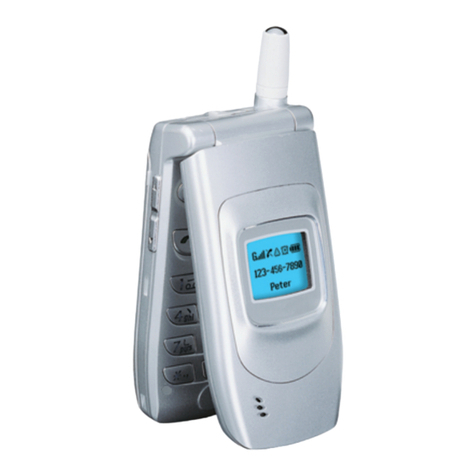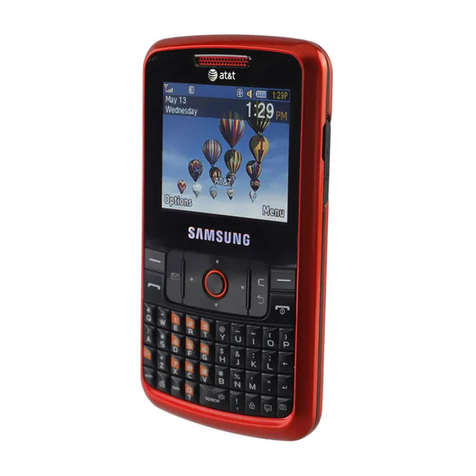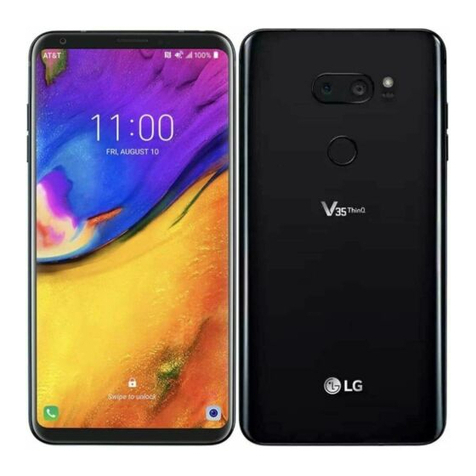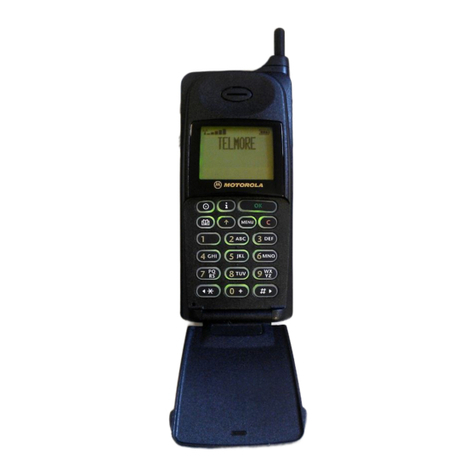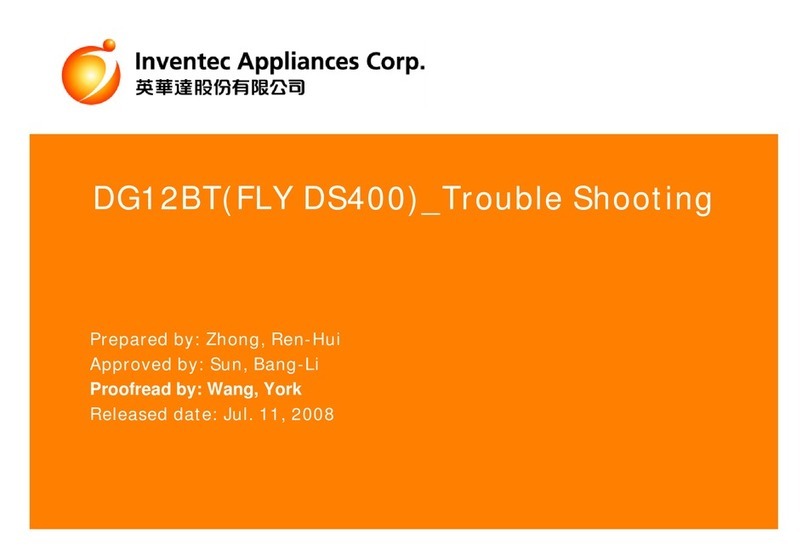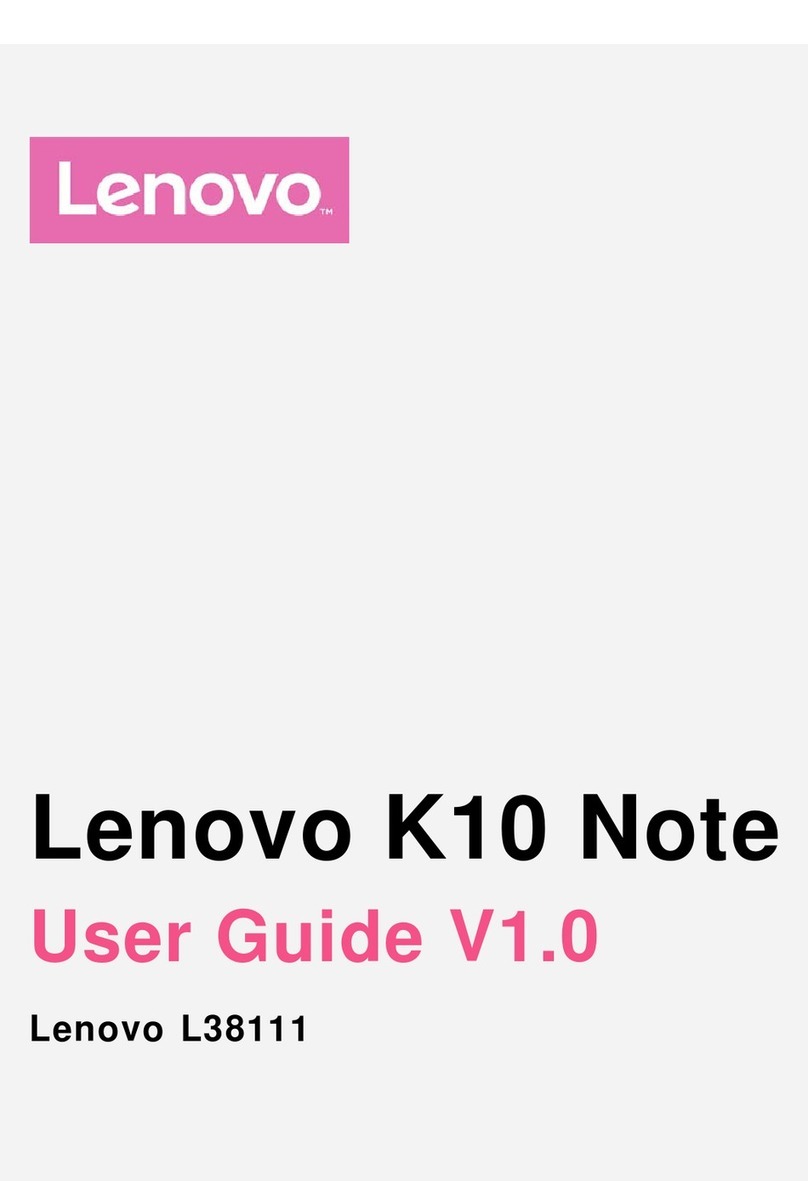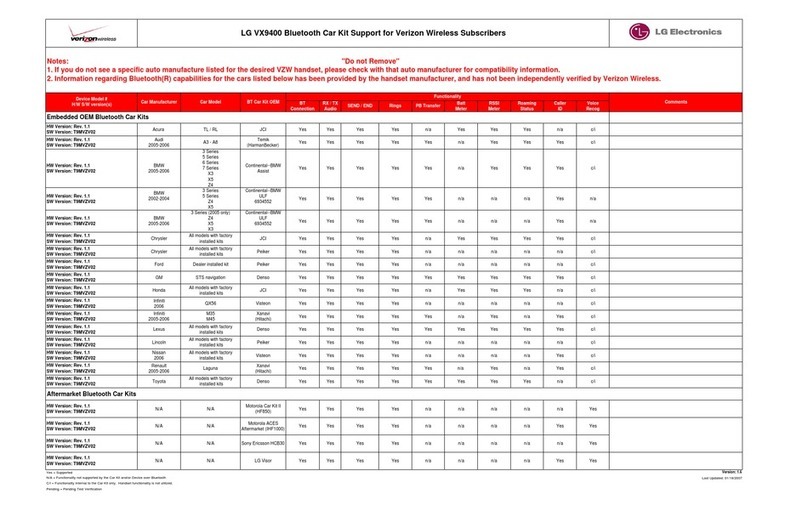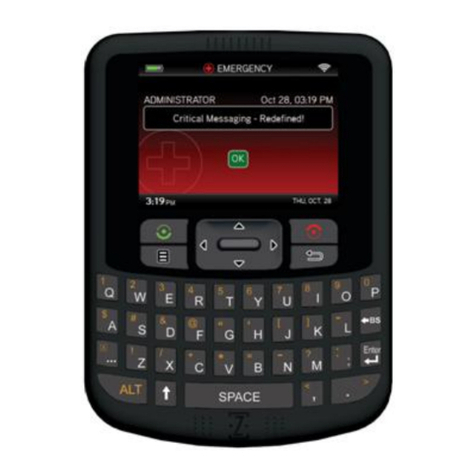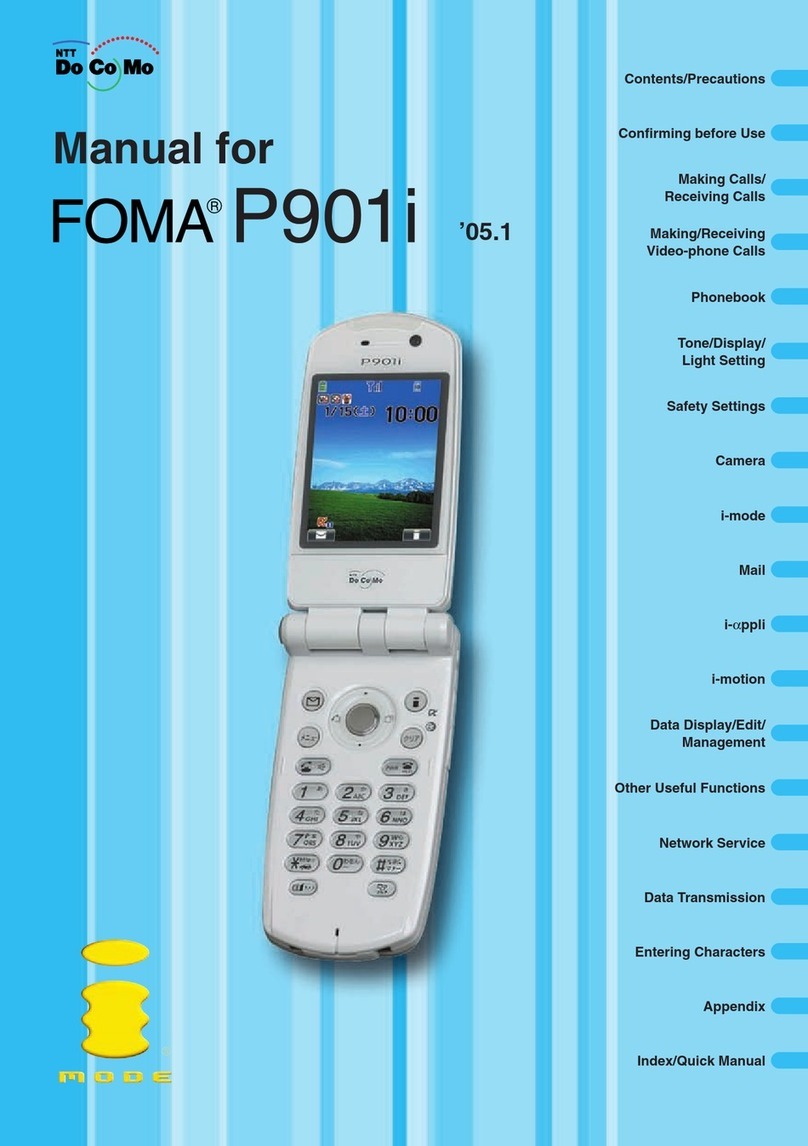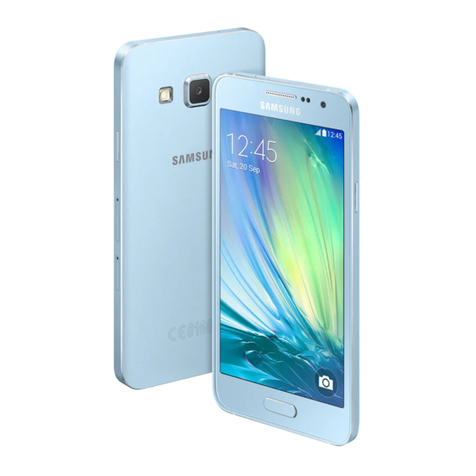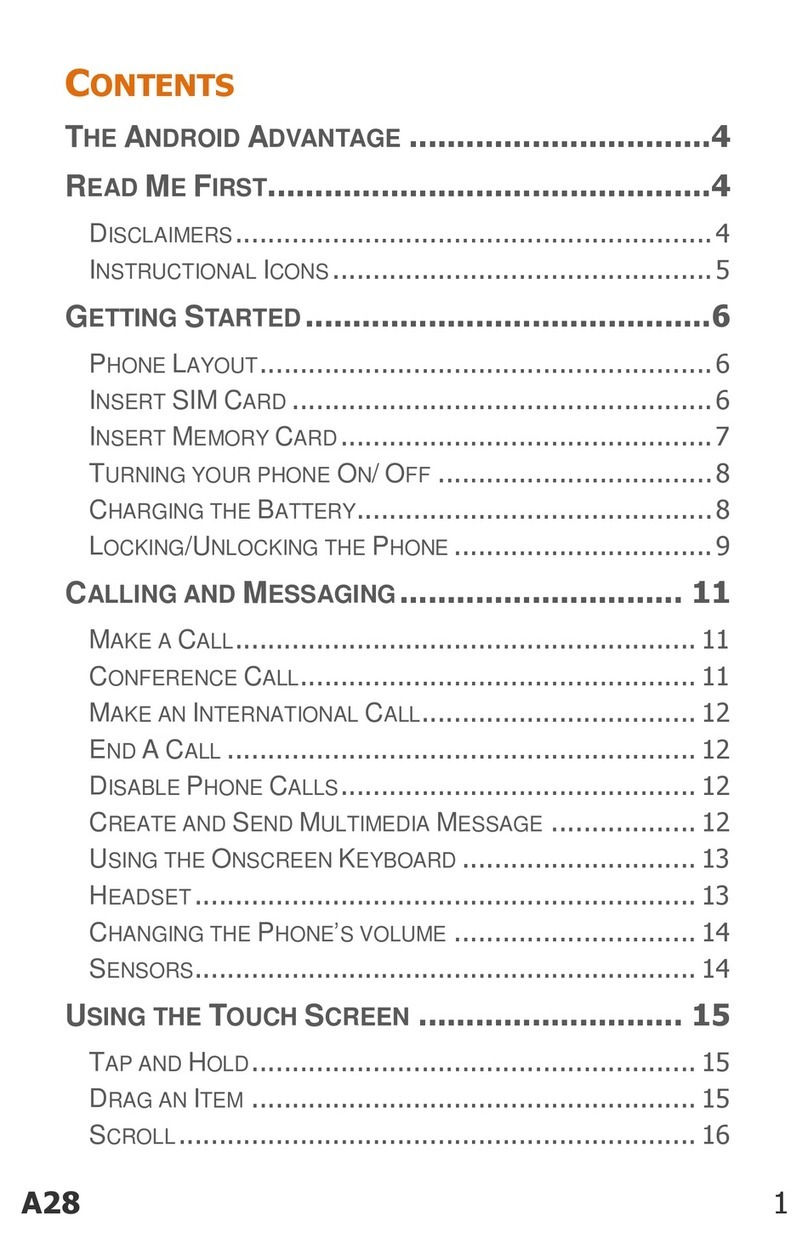Swisstone SNOW WHITE User manual

swisstone snow white
www.swisstone.de
Hotline
01805 014 589

If you need help …
Our hotline
01805 014 589
is available monday to friday from
8.00 am to 5.00 pm (Costs for call from german landline at time
of print: 14 ct/min. Costs may differ with mobile phone pro-
viders.)
IMPORTANT–
Your handset is not supplied with a SIM card.
Your mobile phone will work on all german GSM mobile
networks. You will need to insert a SIM card for the handset to
work correctly.
Unpacking your mobile phone
In the box are:
• the mobile handset
• a mains power adaptor
• the handset back cover
• a rechargeable battery pack Li-Ion 3.7 V
• this user guide
Keep the packing materials for future use.
Keep your sales receipt - it is your guarantee.

Safety notes
• Only use your mobile phone in places where use is not pro-
hibited or capable of creating a hazard: Do not use your
phone in aircraft, hospitals, at petrol stations, in blasting
areas or in the car while you are driving. Observe all app-
licable rules and prohibitions and keep in mind that these are
subject to change.
• Only use approved accessories, especially batteries.
Incompatible accessories and defective batteries can cause
damages up to an including explosions.
• The function of medical devices can be influenced by your
mobile telephone. Manufacturers of cardiac pacemakers
recommend a minimum distances of 20 cm to the device
when the mobile phone is activated. Do not wear your phone
in your breast pocket.
• If you suspect that your phone has interfered with the
function of a medical device, discontinue use of your mobile
phone until you discuss the matter with your physician.
• Keep the phone, power adapter, SIM-card and other
accessories out of reach of children. Small parts can come
loose and could then be swallowed.
• Do not allow small children to play with the packaging film
(suffocation hazard!).
• When unplugging the device, always pull on the plug and
not on the power cable.
1

• This mobile phone is not waterproof –keep it away from
liquids.
• This phone may only be maintained and repaired by
authorised dealers.
• Read the operating instructions carefully and observe all
safety warnings and instructions for operation and disposal
in the appendix before using the devices and keep the
instructions for future reference. If you give the device to a
third party, include these instructions.
General notes
• This mobile phone was developed for operation in GSM 900
and 1800-networks (classification D- and E-Nets in
Germany) – you can receive additional information
concerning the services in these networks from your mobile
provider.
• The SAR-values are:
- GSM900 max = 0.139W/kg,
- DCS1800 max = 0.258W/kg
Install the SIM card and battery
The battery is not placed in the mobile phone in the factory. If
the dealer from whom you purchased the phone had not
already inserted the battery, follow these steps:
2

Before operating the mobile phone a SIM card must be
installed.
To remove the back cover push
in the button at the bottom of the
back cover and slide the cover
down.
Remove the battery by lifting
from the bottom edge.
Carefully slide the SIM card into
the holder with the gold con-
nectors face down and angled
corner top left.
Replace the battery and the
back cover by placing it flat on
the back of the handset and
sliding up until it clicks into place.
3

Charging the battery
Before you start using your mobile telephone, it should be fully
charged (up to 15 hours). Use only the power adapter that
came with the telephone.
The connection port is located on the right side of the device
(see illustration). Do not charge the battery with the battery
cover removed.
The charging process will be shown in the display while it is
charging. If the display shows
No charging
, briefly unplug the
recharger from the electrical outlet and then plug it back in.
Only use the batter that can with your phone or an approved
substitute. Information about this can be obtained from your
dealer or from our service hotline. Use of another recharger or
other types of batteries will extinguish both operating approval
and the guarantee or warranty and can have dangerous
consequences, up to and including [causing the device to
catch] fire.
When the battery has been completely discharged, it can take a
few minutes before the phone shows that it has been
recharged.
4

Connecting a headset
The port can also be used for a headset with the proper plug.
Only use approved headsets.
Symbols on the display
Symbol Meaning
Radio link/signal level
Battery charge level - Charge handset as soon as
possible if it shows nearly empty. While the batteries
are being charged, this blinks.
Call divert activated
Alarm is set
Ringer off
Headset plugged in
New SMS
Keypad is locked
Vibrating ring alert is on
Missed call(s)
Microphone is muted
5

Where to find it
1 Earpiece
2 Navigation keyπ
During call: increase volume
In menus, lists: scroll upwards
In standby mode: access to sound profiles
3 Softkey - perform functions indicated by the display text
above
In standby mode: access to main menu
6
1
2
3
4
5
6
7
8
9
10
11
12

4 Call key
In standby mode: access to redial list
After entering a telephone number: dialling
5 Navigation key √
In standby mode: access to the list of received calls
6 #-key / Keylock (press and hold)
7 Wrist strap holes
8 *-key / switch cases when entering text
(ABC,Abc, abc, 123)
9 Navigation key †
During call: decrease volume
In menus, lists: scroll downwards
In standby mode: access to phone book
10 End Call key
During call signalling: reject call
In menus, lists: back to standby mode
In standby mode: switch phone on/off (press and hold)
11 Navigation key ®
In standby mode: access to the list of missed calls
12 Softkey - perform functions indicated by the display text
above
In standby mode: access to SMS menu
Switching the phone on / off
To activate the phone after inserting the SIM-card
and the battery, press and hold the end key (10) and7

hold it down until the display lights up.
To de-activate, press and hold the end key (10) until
the display goes dark.
Key lock
To protect the phone from unintended use you can
activate the keypad lock. Press and hold the *-key
(6) until the symbol appears in the display. To de-acti-
vate the keypad lock, press the soft key button
"
Unlock
" (3) and then the *-key (6) in rapid
succession.
Making a call
• Key in the telephone number including area code.
To add prefix “+“ press the *-key (8) twice quickly.
• Press the call key (4).
• To end a call press the end call key (10).
Redial
• Press the call key (4).
• Select a telephone number from the list using π/
†.
• Press the call key (4).
8

The menu
Your phone uses simple menus for its settings and use. In
ready mode (inactive), the left softkey is set for the
Menu
and
the right softkey for the
SMS
function.
Press
Menu
to call up the first menu list (the softkeys change to
Select
/
Back
).
Page through the menu list with the πand †keys.
With
Select
you advance to the next screen, and with
Back
you return to the previous screen.
With the end key (10) you break off from the menu and go into
ready mode.
9

Appendix
Care and Maintenance
Your phone was very carefully designed and manufactured and
should also be handled with care. If you observe the
recommendations given below, you fulfil the warranty conditions
and you will continue to enjoy your product for years to come.
• Keep the phone, its parts and accessories out of reach of
small children.
• Keep your phone dry. Rain, moisture and liquids contain
minerals that can corrode electronic circuits.
• Do not use or store your phone is dusty or dirty
surroundings. Its moving parts could be damaged.
• Do not store the phone in hot locations. High temperatures
can reduce the operational lifespan of electronic devices,
damage batters and deform or event melt certain plastics.
• Do not store the phone in cold locations. When it warms up
again (back to normal operating condition), this can cause
condensation to form inside and damage the electronic
boards.
• Do not attempt to open the telephone. The device can be
damaged by improper handling.
• Do not drop, hit or expose the phone to impact and do not
shake it. Rough treatment of this kind can break the circuit
boards inside the device.
10

• Do not use any corrosive chemicals or cleaning solutions or
any abrasive cleaners to clean your telephone.
• Do not paint your telephone. Paint can cause the moving
parts to stick fast and prevent regular operation.
All of the above warnings and instructions apply equally to
the phone , battery, charger as well as all accessories.
Battery information
Your phone is powered by a rechargeable battery. Be aware
that a new battery only reaches full performance after it has
been completely discharged two or three times!
The battery can, of course, be re-charged and discharged
several hundred times, but it will eventually wear out. When the
operational time (speaking time and stand-by) drops sig-
nificantly beneath the normal value, the battery needs to be
replaced.
Use only batteries and chargers approved by your telephone’s
manufacturer. (There is a danger of explosion if the lithium-ion-
battery is replaced with the wrong type or is improperly dis-
posed of.) Remove the charger’s plug from the electrical outlet
when not in use. Do not leave the battery connected to the
charger for longer than a week, since excessive conservation
charging can reduce its lifespan. Afully charged batter will gra-
dually lose its charge over time.
11

Extreme temperatures have a negative influence on the ability
of a batter to receive a charge. Use the batter for its intended
purpose only.
Do not use damaged chargers or batteries. Do not short-circuit
the battery. An unintended short circuit can occur if, e.g. a
metallic object (coin, paperclip, pen) directly connects the
positive and negative poles on the battery (metal strips on the
batter) with each other, as could happen if you keep a spare
battery in your pocket or wallet. Short circuiting the battery’s
poles can damage it or objects attached to it.
The capacity and life span of your battery will be reduced if it is
stored in cold or hot places, e.g. in a locked car during summer
or winter weather conditions.Always store your battery between
15°C and 25°C if at all possible.Aphone with a battery that is
too hot or too cold may in some cases temporarily cease to
function, even if the battery is completely charged. The
battery’s performance is especially impeded in temperatures
significantly beneath the freezing point.
Do not throw batteries into fire!
Batteries must be recycled or properly disposed of.
Batteries do not belong in your household garbage and
may not be disposed of with it.
12

Additional safety information
Traffic Safety
Never use your hand-held phone while driving a motor vehicle.
Always place the phone in its holder or bracket. Do not just lay
the phone on the passenger seat or in a place where it could
become airborne in a collision or a sudden breaking
manoeuvre.
Remember: Traffic safety always comes first!
Operating environment
Follow regulations in force in any area and always switch off
your phone whenever its use is prohibited, or when it may
cause interference or danger, e.g. when driving, on an aircraft,
in a petrol station, in a hospital or any other area with warning
signs.
Parts of the phone are magnetic and may attract small objects,
so check there are no sharp items, particularly by the earpiece.
Do not place credit cards or other magnetic storage media near
the phone, because information stored on them may be erased.
Electronic Devices
Most modern electronic devices are shielded against RF-sig-
nals (radio frequency). However, it is possible that certain
electronic devices are not shielded against the RF-signals of
your mobile telephone.
13

Pacemakers
Pacemaker manufacturers recommend keeping at least 20 cm
between a handheld wireless phone and a pacemaker to avoid
potential interference with the pacemaker. This is consistent
with independent research by and recommendations of
Wireless Technology Research.
If you use a pacemaker, don’t carry the phone in a breast
pocket, use the ear opposite the pacemaker and if you suspect
that interference is taking place, switch off your phone immedia-
tely.
Hearing aids
Mobile phones may interfere with hearing aids.
Other medical devices
Any radio transmitting equipment, including mobile phones,
may interfere with inadequately protected medical devices.
Consult a physician or the medical device supplier to check if it
is shielded adequately from external RF energy.
In healthcare facilities, turn off your phone if official signs,
posters or other posted written regulations require it. In some
cases, devices are used in hospitals or healthcare facilities that
can be sensitive to external RF-energy.
Vehicles
The phone should only be repaired on installed in a vehicle by
trained technicians. Incorrect mounting or repairs can have
14

dangerous consequences and extinguish any warranty on the
device that was still valid.
Regularly check whether the mobile phone equipment in your
vehicle has been properly installed and is functioning correctly.
Do not store any flammable liquids, gases or explosives in the
same room as the phone, its components or accessories.
If you own or operate a vehicle equipped with an airbag,
remember that the airbag fills suddenly and with great force. Do
not mount fixed or moveable mobile phone equipment either
above the airbag or in the area that the filled airbag will occupy.
If an airbag inflates in a vehicle with improperly installed mobile
phone equipment, serious injuries can result.
Prohibited Areas
Always turn off your phone in areas where posted
instructions/prohibitions require it.
Potentially Explosive Environments
Turn off your phone in any area with a potentially explosive
atmosphere and obey all posted signs and instructions. In such
areas a single spark can cause an explosion or a fire which
could result in bodily injury or death. We recommend that
users turn off their phones at petrol stations. Users are
reminded to heed the restrictions on use of radio devices near
fuel depots (storage and sales areas), chemical plants or areas
where blasting operations are in progress.
Places where there is an explosion hazard are often, but not 15

always, clearly identified with signs or other postings. This
would include the lower decks of ships, areas around tanks and
pipelines containing chemicals; vehicles operated with liquefied
gases (e.g. propane or butane) ; areas in which chemicals or
particles such as flour, dust or pulverized metal are in the air; as
well as any location in which you are regularly recommended or
required to turn off the motor of your vehicle.
Aircraft
The use of mobile phones in aircraft is prohibited. Turn off your
phone before you board a plane. The use of a mobile phone on
board an aircraft can have dangerous consequences for the
operation of the aircraft.
Emergency Calls to 112
Important:
Like every other mobile phone, this phone works
with radio signals, mobile telephone networks and land-based
networks as wells as with functions programmed by the user.
For this reason, connections cannot be guaranteed in all
situations. You should not rely exclusively on a mobile phone in
cases where communication is a life-or-death matter (e. g.
medical emergencies).
It is possible that emergency calls cannot be completed in all
mobile phone networks. It is possible that they cannot be com-
pleted while certain network services and/or phone functions
are active. You can inquire about this with your local service
provider.
16

If you make an emergency call, do not forget to give all
information as exactly as possible. Remember that your mobile
phone could be the only means of communication at the
accident site. End the call only when you are told to do so.
IMPORTANT
Since 2009, it is no longer possible to call emergency 112
without an active SIM-card.
You don’t need to have any credit [useable minutes] on
account- but the SIM-card must be registered and unlocked.
17

Protecting the Environment Made Easy
Packaging
Sort the packaging before disposal: Put cardboard
and paperboard in paper, foils or plastic wraps in
recyclable materials.
Batteries and Rechargeable Batteries
Batteries and rechargeable batteries may not be
thrown into the household waste! Every consumer
is legally required to turn in used batteries and
rechargeable batteries to a collection site in
his/her local community or city or a dealership, so
that they can be disposed of in an eco-friendly
manner. This applies whether they contain harmful
pollutants)* or not. Only turn in batteries and
rechargeable batteries in a discharged state. .
*) marked with: Cd=cadmium, Hg=mercury, Pb=lead
Notes on Environmental Protection
Used electronic devices are recyclable materials
and may not be disposed of in your household
waste. Please support us in our efforts to conserve
resources and protect the environment and turn in
this device to a proper collection site.
18
Table of contents
